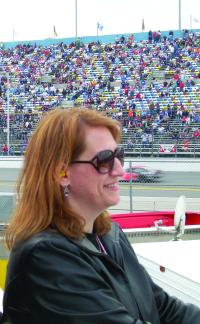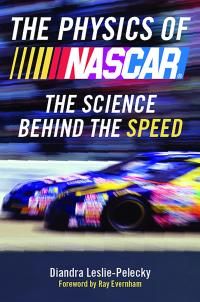Science Writer and NASCAR Expert Diandra Leslie-Pelecky
Fall
2024
Feature
Science Writer and NASCAR Expert Diandra Leslie-Pelecky
Molly McDonough, Graduate Student, Penn State
C6 - Pelecky1.jpg

Diandra Leslie-Pelecky.
“The most important skill a scientist must have is being a pit bull,” she explains. “When you get your teeth around a problem, you just can’t let go of it until you have an answer.”
Like many physicists, Leslie-Pelecky's interest in physics started in high school. “It was the one class in high school I really enjoyed,” she says. “It was the one class that challenged me.” After leaving high school, she became a physics and philosophy double major at the University of North Texas. She found a home in the small physics department. “Having [the department] as a family was really important,” Leslie-Pelecky says. “I dropped out of high school and went to college when I was 16, so having a bunch of surrogate parents was even more important for me.”
Leslie-Pelecky knew she wanted to be a professor, so she applied to graduate school in both physics and philosophy. On choosing physics over philosophy, she explains, “You could sort of study philosophy on your own. It's pretty hard to study experimental physics on your own.” She decided to pursue a PhD in physics at Michigan State University (MSU), studying condensed matter physics.
After graduating, Leslie-Pelecky took a postdoctoral position at MSU while she waited for her husband to graduate from the same physics program. Then she took a tenure track physics faculty position at the University of Nebraska. Six years later, she moved to the University of Texas at Dallas and, later, to West Virginia University.
Leslie-Pelecky had a passion for writing, but it was difficult to pursue on top of being a professor. “The problem is, you can be really good at one thing at a time. And if you're trying to run a lab and mentor graduate students, you can’t have other distractions; it’s just too competitive,” she says.
Then the NASCAR crash piqued her curisoity. She got hooked on wanting to know why racing cars fail and the physics behind the failures. “At that time, NASCAR had maybe five or six people with PhDs working among the various teams. So I started with those folks because we all spoke the same language,” she says.
As she dug deeper into the physics of racing, Leslie-Pelecky realized she could teach the entire first semester of physics in the context of NASCAR, which she says “is so much more interesting than a ball rolling down an inclined plane.” This inspired her to write a popular science book, The Physics of NASCAR: The Science Behind the Speed, which kicked off her writing career.
Today, Leslie-Pelecky is a full-time writer, public speaker, and go-to NASCAR expert. She attends dozens of races each year and has written articles on NASCAR and other topics for publications including NBC Sports, Time magazine, and the New York Times. She blogs regularly at Building Speed: The Science of Fast at buildingspeed.org.

